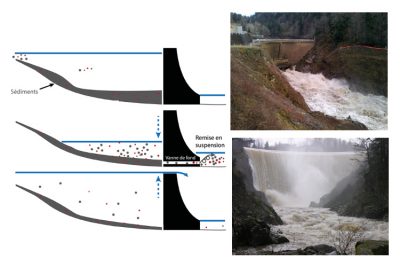Some examples of sediment management
PDFIn France, the methods generally considered and implemented are the cleaning of sediments that may be spread on the surrounding land for amendment purposes. Nevertheless, sediment quality must be proven (through relevant and robust analyses in advance) and this solution involves significant operational and transport costs.


During the operations of sluicing, as with flushing operations, the tank level is lowered during high water periods, which will allow water and sediment to be conveyed to the discharge valves at high speed. The realization of operations of sluicing and flushing depends on the hydrological characteristics of the catchment area and the size of the reservoir concerned. Both of these operations have low impacts on aquatic ecosystems.
As for the operations of drawdown flushing, the aim is to lower the water level in the reservoir completely, an operation that takes place during low water periods, often just before the flood season. This involves scouring and resuspending sediments deposited within the dam to transport them downstream. During this type of operation, only the fine sediments in the centre of the reservoir channel (the original river channel) will be eroded and transported, as lateral sediments are generally not or only slightly discharged. These operations are very effective for narrow valley and small reservoir configurations as well as for rivers with high contrast seasonal flows. They are practised in many countries, including France, on the Rhône for example, but they can nevertheless have harmful effects on aquatic ecosystems (up to 60% mortality in adult fish [3].
References and notes
Cover image. The Sanmenxia gravity dam on the Yellow River in China. [Source: CC BY-SA license, from: https://alchetron.com/Sanmenxia-Dam]
[1] Frémion, F. (2016). Dynamics of sedimentary flows and metallic elements related to the current and exceptional operation of a hydroelectric dam. Doctoral thesis in Environmental Sciences, University of Limoges.
[2] Kondolf, G.M., Gao, Y., Annandale, G.W., G.W., Morris, G.L., Jiang, E., Zhang, J., et al. (2014) Sustainable sediment management in reservoirs and regulated rivers: Experiences from five continents. Earth’s Future, 2, 256-280
[3] Grimardias, D., Guillard, J., Cattanéo, F., (2017). Drawdown flushing of a hydroelectric reservoir on the Rhône River: Impacts on the fish community and implications for the sediment management. Journal of Environmental Management, 197, 239-249




